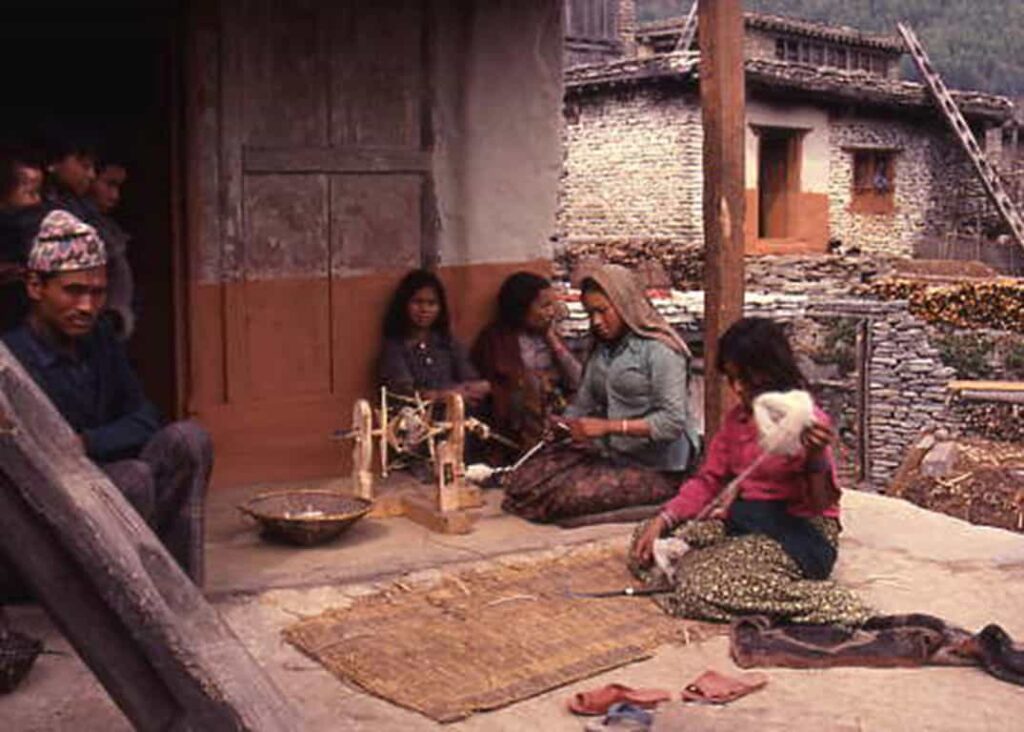The Thakali people are a cultural and linguistic group that originates from the Thak Khola region of the Mustang district in the Dhaulagiri zone of Nepal. The Thakali people have maintained many of their unique cultural traditions despite influences from neighboring groups over the centuries. Their language, cuisine, and trading history make them a distinct ethnic community in the Himalayan region of Nepal.
Thakali People in Population Nepal
According to the census 2001, 12973 the Thakali population constituted only 0.06% of Nepal’s population, on the 2011 Nepal census, 13,215 Thakali people living in Nepal, and the latest (2021 census) there are currently 11,743 Thakali People are living in Nepal.
Also Read: Kirat People Of Nepal
Many of the Thakali people are settled in Kathmandu. The Central Bureau of Statistics of Nepal classifies the Thakali people as a subgroup within the border social group of mountain nationalities (Janajati).
Origin of Thakali People
The origin of the Thakali people is said to be that they are traced back to the ancient Newari kingdom of Kathmandu. The Newari kingdom was an influential and important one that had a rich cultural heritage and practiced a unique form of Hinduism. The Thakali community is believed to be the descendants of this ancient dynasty.

The Thakali culture shares several similarities with the Newari culture but also boasts its own distinct elements. The Thakali people have long been settled in the region, forming small settlements and villages, but have recently seen a surge of migration to the cities.
But it is said to be also that the origin of Thakali is not clear, although they claim to be the descendants of Hansraj who is known as the Thakuri prince of the Jumla Sinja dynasty in western Nepal.
Religion and Culture
Thalaki culture reflects syncretic Tibetan-influenced and Hinduised customs following ancient trade exchange. They used to speak Thakali manifest language such mixtures becoming distinct enough for their scripts and dialects like marphali, Panchgaunle, and tin gaule spoken across sub-Himalayan valleys.
The culture of the Thakali people is deeply embedded in their religious beliefs and practices. It is a blend of traditional and modern elements that create a vibrant identity.
You May Find Interesting: Newar People of Nepal
The Thakali culture has a deep focus on the spiritual aspects of life, with numerous rituals and practices that are connected to the worship and veneration of Lord Shiva.
They also have a complex system of values that encompasses their beliefs around morality, ethics, and social norms. The Thakali culture also has elements of traditional arts and crafts, like weaving, embroidery, and woodwork. They are also passionate about cuisine and celebrate numerous festivals.
Kinship
The thakali community is composed of four ancestors. They are Gauchan, Tulachan, Sherchan, and Battachan. These four clans have their respective deities.
The goddess of gauchan is called LhaLongbaNorbu.
The Tulachan goddess is called LhaChurinGyalmo.
The goddess of Sherchan and Battachan is called LhaRyabaRyanjung.
Thakali People Occupation
They are mainly known as traders or salesman. The occupation of the Thakali people is varied. Historically, they have been mainly involved in agricultural activities like farming and animal husbandry. They have also been engaged in cottage industries such as weaving, woodworking, basket weaving, etc.

In modern times, many Thakalis have migrated to the cities in search of work. They are engaged in jobs and businesses across the service sector, construction, and various trades. A small number of them are also involved in tourism activities.
Thakali Priest
Thakali people’s priests are Dhong, Dongba, and Lama. The priest is responsible for conducting rituals, prayers, and other religious activities. They play a vital role in protecting their traditions and culture. Also as for the promotion of spiritual values of the community.
Thakali Dress and Ornaments
Thakali people have their cultural dresses. Their cultural dress reflects the ancient heritage and history of the community.
Recommended for You: Bahun People of Nepal
The Thakali women wear a sarong and blouse. They wear sari, cholo, patuki, teki. In winter they wear woolen sweaters, shawls, and an overcoat or jacket. Thakali men wear Labeda, Istakot, and coats. And others some ornaments with their cultural dresses.
Thakali People Festivals
Thakali people celebrate diverse and unique festivals every year. they celebrate Toran La which has its own significance and makes Thakali people so special. This festival falls on the same day as Holi. The festival is similar to Dashain, where they used to clean the houses, cook delicacies, gather relatives, and do merrymaking. It is a three-day festival on the three nights, before, after, and the night of Purnima, and It is celebrated on the first month of a new year of the Thakali calendar which usually falls in the month of March.
It is celebrated to worship the ancestors and forefathers appreciating what their ancestors have done for their community. Taron La is very meaningful for Thakali people which teaches the future generation to pay respect and homage to their ancestors.
Thakali Cuisine
Thakali people liked to serve the dish like Dal, Bhaat, Tarkari and meat along with buckwheat finger chips called Kanchhemba, the mustang Alu topped with jumbo( Himalayan leaf garlic) and a generous dollop of ghee.

More: Sherpa People: Bravest Heroes of Mountains
The styles of preparation of Thakali food are different due to the use of some ingredients that are characteristics of Thakali cuisine like suki or dried goat or yak meat, Gundruk with soya beans along with green cabbage, buckwheat, barley flour, and Timber. These spices give the cuisine a whole new taste and flavor.
Let our expert team at Asian Heritage Treks and Travel take care of everything — from guided tours to personalized packing tips and travel arrangements.
Plan an exciting trip







